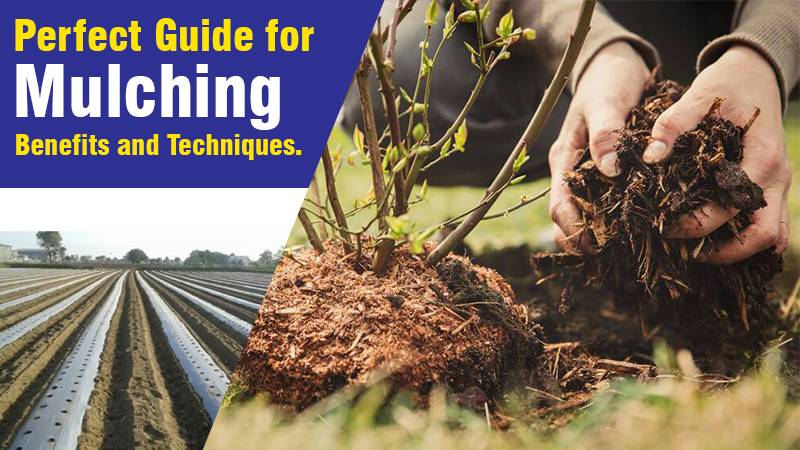Mulching is a conventional practice in Indian agriculture. It is a technique for covering the farmland with natural items or plastic sheets of permitted thickness.
In natural cultivating, husk, leaves of the plants, twigs, bark, and so forth are utilized to make defensive cover around the plants.
In Inorganic cultivating, plastic sheets are utilized as a defensive layer around the plants.
As they are not decayed after gather, they can be saved for next season in the wake of washing. Here we are going to discuss modern plastic mulching techniques in detail.
Utilization of Mulching
Mulching is fundamentally utilized for moisture content preservation in rainfed regions It may be used to decrease irrigation recurrence and for water saving in irrigated regions. Mulching is used for Soil temperature control in nursery development.
Selection of Plastic Mulch –
The selection of mulches relies on the environmental circumstances, soil physical condition, crop type, germination period of crop, etc.
Basic Properties of Mulching Sheet –
Air proof nature of this sheet is not to allow any moisture content to get away. This sheet also comes with thermal-proof nature for conservation of temperature. These sheets are durable enough for at least one yield season.
Techniques for Mulching –
- The mulching region ought to ideally be comparable to the canopy of the plant.
- The required size of mulch film is cut from the fundamental rolls.
- Clean the necessary region by eliminating the stones, rocks, weeds, and so on
- Till the soil well and apply a little amount of water prior to mulching
- The small channel could be made around the outskirts of the mulching region to work with the mooring of the mulch film.
- Cover the film to the whole region around the tree and the end ought to be covered in the ground.
- Semi-round openings could be made at four corners of the film for water movement.
- Mulch ought to be laid on a non-breezy condition
- The mulch material ought to be held tight with no wrinkle and laid on the bed
- The seeds/seedlings ought to be planted/relocated in the openings.
Safety Measures for Mulch Laying –
Do not extend the film firmly. It should be adequately free to defeat the extension and shrinkage conditions brought about by temperature and the effects of intercultural tillage operations.
The slackness for dark film ought to be more as shrinkage marvel is greatest in this tone. The film should not be laid on the hottest day time when the film at in extended condition due to high temperature.
Irrigation in Mulching –
In a drip irrigation system, the pipelines are laid under the mulch film but on the off chance that intercultural operation should be completed, it is smarter to keep the laterals and drippers on top of the mulch film and control the progression of water through a little line or through the openings made on the mulch film.
In the case of flooding, irrigation system water goes through the semi roundabout openings on the mulch sheet.
Benefits of Plastic Mulching –
- It is totally impermeable to water.
- It forestalls the immediate evaporation of moisture from the soil and in this manner restricts water misuse and preserves the moisture content of the soil.
- It forestalls the ascent of water containing salts.
- Mulch can work with compost situations and diminish the deficiency of plant supplements through draining.
- Mulches can likewise give a boundary to soil microorganisms
- Prevent germination of yearly weeds from getting light
- Mulches will repulse certain creepy crawlies
- Mulches keep a warm temperature in any season, which empowers seeds to develop rapidly and for youthful plants to quickly build up a solid root development framework.
- Higher in carbon dioxide under sheets because of the greater degree of microbial action helps to create a microclimate.
- Under mulch, the soil structure is kept up
- Early germination is just about 2-3 days.
- Better nodulation in crops like Groundnut. Fewer nematodes populace.
- Water disintegration is totally deflected since the soil is totally covered structure bearing activity of downpour drops.
How Mulching Helps to Control Weeds –
The black plastic film doesn’t permit the daylight to give through to the soil so that Photosynthesis doesn’t happen without daylight beneath dark film subsequently, it controls weed development under a film.
Limitations of Plastic Mulching –
- They are expensive to compare with natural mulches.
- Probability of burning of the young plants because of the high temperature of the dark film. Difficulty in the utilization of top-dressed compost
- Reptile development and rat may take place about certain crops.
- More runoff of water
- Environmental contamination
- Difficult in the movement of farm machinery
- Toxic to domesticated animals
Download the KhetiGuru Mobile application for more details about new agriculture techniques.
Also visit our page for more information about Tractor, Agricultural implements, Tractor Price, Tractor Videos, and Tractor Games.



